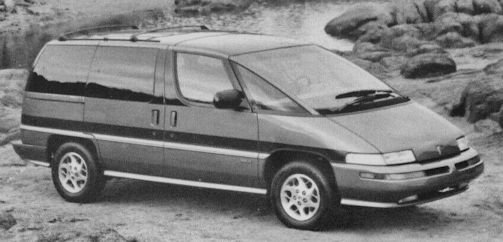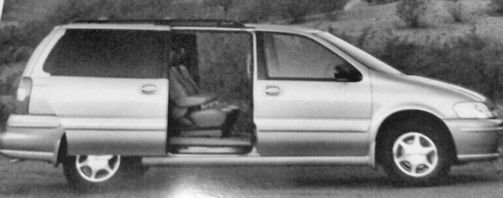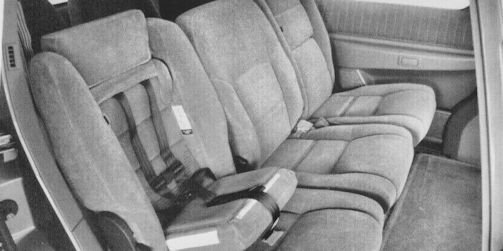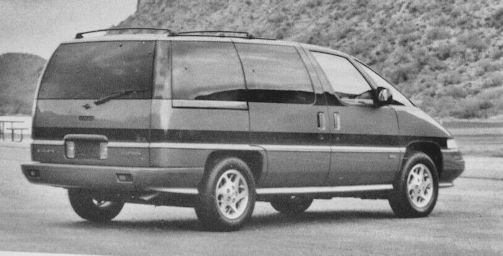Oldsmobile Silhouette First Generation
 |
|
|
Production period: |
1990 to 1996 |
|
Body versions: |
station wagon |
|
Engines: |
Gasoline: 3.1-3.8 litres(88-136 kW) |
|
Length: |
4933-4945 mm |
|
Width: |
1877 mm |
|
Height: |
1656-1669 mm |
|
Wheelbase: |
2789 mm |
|
Curb weight: |
1630-1766 kg |
The production of the first generation of the Oldsmobile Silhouette began on 1 August 1989 in Tarrytown (New York). The cars were built on the GM-U platform and consisted of a space frame made of galvanized steel and carried a body made of GRP, which was insensitive to rust and minor damage. This production technique was developed on the Pontiac Fiero and also used for most Saturn cars. The silhouette had seven seats; The five rear seats each weighed about 15 kg and could be removed individually.
History
The Oldsmobile Silhouette and its sister models Pontiac Trans Sport (later Pontiac Montana) and Chevrolet Lumina APV (later Chevrolet Venture) were three vans that were presented in the 1990 model year. After giving up the brand Oldsmobile 2004, the silhouette was replaced in the following year 2005 by the Buick Terraza.
The concept car Pontiac Trans Sport was presented to the public in 1986 and received very well. It had a futuristic styling, individually convertible seats with built-in stereo speakers, a rear door wing door and large glass surfaces, including a large glass roof.
Due to the positive response, the production of the Pontiac Trans Sport was recorded, but the styling and the equipment details of the concept vehicle were only partially taken over in the series production. Especially the hinged door would have been too expensive in production. The glass roof was also too heavy and also too expensive, and so it was left in the production vehicle at a steel sunroof, which was painted in high-gloss black, reminiscent of the glass roof of the concept vehicle.

Also, Chevrolet and Oldsmobile received modified versions of the Trans Sport to serve the largest possible clientele. The Chevrolet Lumina APV should be the cheapest version, the Trans Sport was designed for customers with a sense of "style & sport", and the silhouette should be the van for the market of luxury vehicles.
There was a self-levelling system with a supercharged compressor and rear gas pressure dampers so you could adjust the vehicle level regardless of the load. In addition, there was a switch combination and a set of air hoses, so that one could inflate with the compressor also the tires, air mattresses and other sports equipment.
The styling of the Vans was discussed very controversial. When the Oldsmobile Silhouette and its sister models hit the market, no one had ever tried to market an elegant or sporty van, and GM thought they had discovered a great deal of market potential. These vans have been built lower and slimmer than any other vans so far. The extremely long and flat windshield and the resulting large distance from the driver to the bottom of the window made for a peculiar driving feel, until the driver had got used to the "slightly different" proportions. Automobile magazines called the car "Dust buster" because it looked similar in its side silhouette to this hand vacuum cleaner.
STANDARD EQUIPMENT:
GL Base: 3.4-liter V-6 engine, 4-speed automatic transmission, driver-and passenger-side air bags, front side-impact air bags, anti-lock brakes, daytime running lights, front air conditioning, interior air filter, power steering, tilt steering wheel, cruise control, reclining front bucket seats w/lumbar adjustment and folding armrests, 4-way adjustable driver seat, second-row 2-passenger split-folding bench seat, third-row 3-passenger split-folding bench seat, front storage console, under-passenger-seat storage drawer, overhead console w/map lights, cupholders, heated power mirrors, power windows,power door locks, tachometer, coolant-temperature gauge, trip odometer, AWFM/cassette, integrated antenna, digital clock, intermittent wipers, rear wiper/washer, rear defogger, automatic head-lights, visor mirrors, rear reading lights, auxiliary power outlets, floor-
mats, sliding driver-side door, solar control windshield, deep-tinted glass, theft-deterrent system, fog lights, roof rack, 215/70R15 tires,wheel covers.
GS adds: remote keyless entry, power sliding passenger-side door,6-way power front seats, overhead storage console (includes compass, outside temperature indicator, driver information center), illuminated visor mirrors, deletes under-passenger-seat storage drawer.
GLS adds: leather upholstery, second-row captain's chairs, leather-wrapped steering wheel w/radio controls, rear-seat radio controls,215/70R15 touring tires, alloy wheels.
Premiere Edition adds: traction control, LCD color screen/video-cassette player, input jacks for video games or video camera,AM/FM/cassette w/two CD players, rear air conditioning and heater, touring suspension w/automatic load leveling, air inflation kit.
The first engine for this van was a slightly weaker 3.1-liter V6 with only 120 bhp (88 kW), which did not give this fairly heavy car sufficient performance.
In 1992, the Silhouette and its sister models got a 3.8l V6 with 170 bhp (125 kW) on request, which gave the van a much better torque and better acceleration and made them the strongest and handiest vans of their time.
In response to the criticism (and very modest sales figures) attributed to avant-garde styling and the reaction of potential customers, car magazines and even a 1994 Chrysler ad, the Trans Sport and the Lumina APV got a facelift by: her nose was shortened by 3 "(76 mm) and the car's front bent down, giving it a more conventional look. In addition, an edge was attached to the dashboard to visually shorten the distance to the bottom edge of the windshield.

The European customers, who were already used to slim Vans by the Renault Espace, took the futuristic styling well, and the sales figures were handsome. The Oldsmobile Silhouette, manufactured from 1994 for the European market, became Pontiac Trans Sport models through Pontiac logos and wheels. The sales figures in Europe were good - at least for a US import car - but did not economically justify a separate, fourth model.
The production of the Silhouette (including Lumina APV and Trans Sport) of the first generation expired in 1996 and the plant in Tarrytown, where the cars were manufactured and operated since 1900, was cancelled. The last Oldsmobile silhouette of the first generation left this factory on 17 May 1996.
Engines
- 1990-1995: 3130 cm³ V6-60 °, 120 bhp (88 kW)
- 1992-1995: 3785 cm³ V6-60 °, 170 bhp (125 kW)
- 1996: 3392 cm³ V6-60 °, 170-185 bhp (125-136 kW)
Model History
1990
- A brand-new model - The Silhouette as a luxury model is available with leather seats on request, a trim detail that its sister models cannot offer, but the Chrysler Town and Country.
1991
- Customer complaints due to reflections of the huge dashboard in the windscreen are answered by the exchange of bright plastic parts of the previous year for black carpet.
1992
- New this year is the 3.8L V6 engine in conjunction with a Hydra-Matic 4T60 four -speed automatic transmission with electronic control.
- The fixed radio antenna mounted on the bulkhead is abandoned in favour of an integrated roof antenna. It is installed between the roof and the headliner.
- The side mirrors are now foldable and larger.
- The brakes are enlarged and combined with ABS as standard.
- On request there is a lifting roof.
- On request, there are control levers for the stereo system on the steering column.
1993
- The design of the taillight’s changes from a mesh design to red lamps that run to the edge of the black. This equipment was previously only in Trans Sport.
- There was a new centre console with large, recessed controls for the air conditioning and large shelves.
1994
The silhouette received a facelift with reaching around the corners of the vehicle, combined flashing and parking lights and standard installed fog lights.
In addition, there was an electric sliding door with remote control and the rear side windows got a darker tint.
Until 1995, an ESP was offered in combination with the 3.8 -Liter engine and there was also an optional traction control and a standard driver's airbag. Optional built-in child seats were available, which could be installed between two of the rear adult seats. To visually reduce the large distance to the lower edge of the windshield, you brought an additional edge on the dashboard.
1995
- There were automatic door locks that locked the doors when the auto selector was pushed out of park and unlocked when the car was parked.
1996
- Last year of production. In August, the series will be replaced by a newly developed car of the same name.
- Both the 3.1-liter V6 and the 3.8-liter V6 are eliminated, but there is the 3.4-liter V6 engine.
- The traction control is eliminated.

Manuals
-
Oldsmobile Previous 16 / 21 Next
